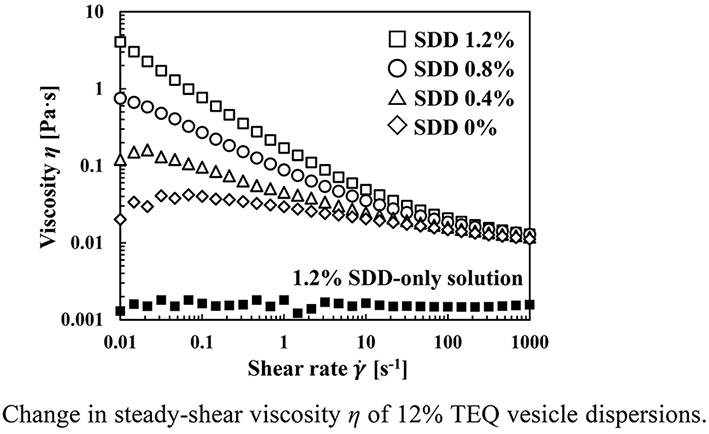- 著者
- Asami Miyajima Ryo Inoue Erika Onishi Miyuki Miyake Ryo Hyodo
- 出版者
- Japan Oil Chemists' Society
- 雑誌
- Journal of Oleo Science (ISSN:13458957)
- 巻号頁・発行日
- vol.68, no.9, pp.837-845, 2019 (Released:2019-09-04)
- 参考文献数
- 30
- 被引用文献数
- 1 2
Producing structural viscosity in colloidal dispersions, such as vesicles and capsules, prevents separation of dispersed particles by increasing the viscosity between them, which is advantageous in terms of usability. So far, the separation behavior of various particles has been studied; however, there are very few examples wherein a stable dispersion state was constructed and controlled. In this study, we produced stable dispersions induced by the depletion effect in mixtures of vesicles of cationic surfactant derived from triethanolamine-based esterquat (TEQ) and a specific dextrin derivative (SDD) as a non-adsorptive polymer. In the composition region, where 8 to 16% of TEQ vesicles and 1.2% or less of SDDs were mixed, the viscosity increased proportionally with the particle concentration, and it was observed that stable dispersions were produced by structural viscosity. Furthermore, the effects of TEQ and SDD concentrations, and SDD size on the structural viscosity and cohesive energy were investigated, which were similar to the depletion effect in the Asakura–Oosawa (AO) theory. From the results, it was suggested that the structural viscosity of the mixed dispersions (TEQ vesicles and SDDs) was produced by the aggregated TEQ vesicle networks induced by the depletion flocculation.
